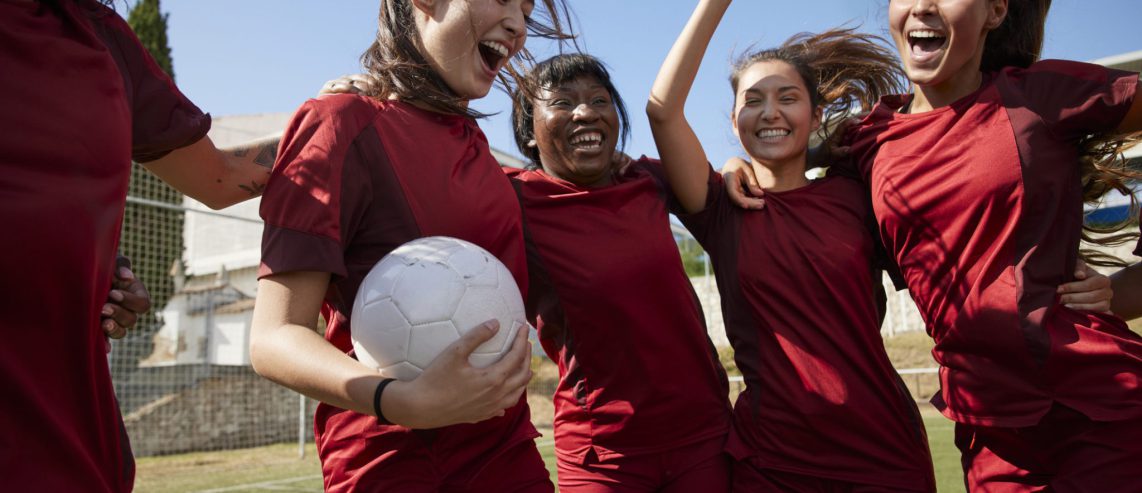Never Miss a Beat!
Subscribe to Our HealthBeat Newsletter!
Thank you for subscribing!
You can now select the specific newsletters you'd like to receive.
You are already subscribed.
Subscribe to more newsletters in our email preference center.
Sorry, an error occurred. Please try again later.
Get Healthy Tips Sent to Your Phone!
ACL Injuries in the Female Athlete
More women and girls than ever are participating in competitive sports. But emergency department statistics indicate that female athletes are more susceptible to tears of the anterior cruciate ligament (ACL) than males are.
In fact, female athletes tear their ACLs at an alarmingly higher rate — 2 to 8 times more frequently — than male athletes. For example, according to the National Institutes of Health, the incidence of female to male ACL injuries is 3.5 times greater in basketball and 2.8 times greater in soccer.
How Do ACL Injuries Occur?
The ACL is one of the main ligaments that stabilizes the knee joint. It connects the femur (thighbone) to the tibia (shinbone).
A non-contact ACL tear usually happens when an athlete makes a rapid but awkward stop in anticipation of a lateral movement.
ACL injuries tend to happen when athletes are decelerating, changing directions, or landing. During these maneuvers, female bodies may move differently than male bodies, putting them at a higher risk of injury.
The hamstring muscles in the back of the leg and the quadricep muscles in the front work together to move the leg. When you bend your leg, the hamstring muscles contract, and the quads relax. Conversely, when you straighten your leg, the quads contract and the hamstring muscles relax.
Female athletes can take steps to strengthen their hamstrings and use different body mechanics to get back to playing after an ACL injury. This is according to Volker Musahl, MD, a world-renowned sports surgeon and chief of the Division of Sports Medicine at UPMC.
The same steps that can help them recover from an ACL injury can also help prevent the injury altogether.
“When I do evaluations through the ACL Program at UPMC Sports Medicine, I ask the athletes to stand up on a box and jump down and land, or jump down, land, pivot, and run,” Dr. Musahl says. “When women and girls jump down, they tend to land knock-kneed with straighter legs, while men and boys land with knees straight out and more bend in the legs. But when female athletes are taught a different way to land on their feet, we can treat the movement that’s putting them at risk.”
How Can Female Athletes Prevent ACL Injuries?
One way for female athletes to reduce their risk of ACL tears is to build and maintain leg strength year-round — not just during their sports season. Exercises the UPMC ACL Program recommends include:
- Quad sets.
- Straight leg raises.
- Backward leg raises.
- Hip abduction.
- Squats.
- Wall sits.
- Reverse lunges.
- Bridges (short leg and long leg).
- Planks and side planks.
“There’s really nobody who is too young to learn ACL prevention exercises and improved body mechanics,” says Dr. Musahl. “In fact, it would be great if schools would teach these exercises because the younger the person, the more teachable they are.”
Dr. Musahl adds that early sports specialization can increase the risk of girls and women sustaining ACL injuries.
“I always refer to hockey great Wayne Gretzky as a good example of a multisport athlete. He played a lot of different sports when he was young then specialized at an older age and was able to stave off serious injury throughout his professional career,” he adds. “Playing different sports when young diversifies the training of both the muscles and the brain, which helps the athlete grow stronger all over.”
Top 3 Tips for Preventing ACL Injuries
There are steps you can take to reduce your risk. Here are Dr. Musahl’s top tips for preventing ACL injury:
- Become a multisport athlete.
- Respect the three Rs: rest, recovery, rehydration. No one can train seven days a week — not even the pros, so make sure to give your body time to rest and recover. “For example, train three to four days, then rest one day before game day,” Dr. Musahl says. “And make sure to hydrate before and rehydrate after your workouts.”
- Enroll in an ACL injury prevention program or go online for a good app. “Spend a few minutes per day doing prevention exercises,” he recommends. “The Nordic hamstring curl is a good one, and it can be done with or without a partner.”
The Nordic hamstring curl is an eccentric hamstring curl, which means that the hamstring muscle gets longer but stays active during the exercise.
To do the Nordic curl, kneel down on a mat and have your partner hold your ankles down on the floor. (If doing this curl on your own, put your ankles under a loaded barbell or other immovable object.)
Keeping your body straight, lean forward from the knee (not the hip) toward the floor as close to the floor as you can without using your arms or hands. Move slowly and with control. Only put your hands out in front of you on the floor when you can no longer hold yourself up with your legs.
Then, push yourself back to the starting position and repeat. Count how many you can do and try to add a rep each time you do the exercise.
Editor's Note: This article was originally published on , and was last reviewed on .
About Sports Medicine
An athletic lifestyle carries the potential for injury. Whether you’re an elite athlete or a weekend warrior, UPMC Sports Medicine can help. If you are looking to prevent, treat, or rehabilitate a sports injury, our multidisciplinary team of experts can help you get back into the game. If you are seeking to improve your athletic performance, we can work with you to meet your goals. We serve athletes and active people of all ages and experience levels. Our goal is to help you keep doing what you love. Visit our website to find a specialist near you.

